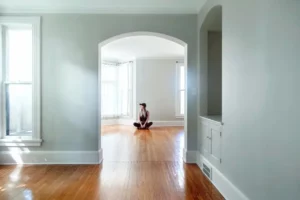Article updated on May 31, 2023.
Has your lease contract not reached its end yet and you’re already planning to leave your apartment? For whatever reason, your decision to leave is valid. However, you’ll need to fulfill one condition: terminate your lease. The actual termination of the lease will differ based on the nature of the signed rental contract. For compliance, your contract will take the form of either an individual lease or a single lease, collectively applying to all roommates. It goes without saying that it’s easier to leave your shared accommodation if each remaining person has signed an individual lease contract. In either case, you will need to follow a multi-step process. Find all our tips and advice so you can take leave of your shared room in the best possible way, and of course, end your contract while respecting some essential modalities.
Different types of shared leases
- The individual lease:
Just like in a traditional rental, each roommate is considered as a unique tenant of their private space: their room. This type of lease also encompasses all the shared areas of the accommodation. It’s advantageous as roommates are not tied to one another, thereby maintaining their independence. They simply share the same living space.
- The single lease:
As its name suggests, the names and signatures of all roommates are listed on this lease. They all hold equal standing on this contract and are regarded in the same way, sharing the dwelling equally. In this type of lease, amendments can be incorporated into the initial contract in case one of the roommates leaves or a new one moves in.
In the majority of contracts of this type, this lease quickly transforms into a “joint and several lease”. If one of the roommates were to leave, the remaining occupants would be obligated to pay the entirety of the shared rent. A joint and several lease includes a solidarity clause. This clause ensures that the landlord receives all rents, even if one of the roommates left the dwelling. The ALUR law has established rules for shared accommodation. By revising the law of July 6, 1989, it governs rental contracts. The departing roommate sees his solidarity period reduced if he is not replaced. The solidarity clause persists until a new roommate replaces him or up to 6 months after his departure. The leaving tenant will have the obligation to fulfill his financial role until the end of his notice period only. Thanks to this solidarity clause, the landlord can demand a single tenant to pay all the rents and charges.
Do you want to know more about the shared accommodation lease? Discover more in our dedicated article.
Notice of termination of a shared accommodation lease
Of course, you cannot leave your room from one day to the next. In the event of a lease termination, the departing roommate is obligated to observe a notice period defined and imposed in the clauses of the rental contract. These conditions may vary depending on the nature of the rented accommodation. Indeed, the rental can be either unfurnished or furnished. Flexibility can also be granted based on other criteria, such as the property’s location or in the case of a career change. For instance, if the property is situated in a high-demand area, the notice period is reduced to 1 month.
To make this more understandable for you, everything is explained in the table below:
| Notice of termination table | ||
| Individual lease | Single lease | |
| Unfurnished rented accommodation | 3 months | 3 months |
| Furnished rented accommodation | 1 month | 1 month |
However, other criteria can lead to a reduction in the notice period stipulated in the shared lease contract, such as:
- Geographical location – As we mentioned earlier, if the property is located in a high-demand area, the notice period may be reduced to 1 month.
- Health problem – Life is full of surprises, which is why the law also provides for a reduction in the notice period in case of health issues. You will only need to present a medical certificate to your landlord.
- Change of status / social assistance – If you receive benefits such as the RSA (Revenue of Active Solidarity) or the AAH (Disabled Adult Allowance) then your notice period may also be reduced.
- Work – Finally, you may see your notice period reduced in cases of force majeure such as a transfer or obtaining a (first) job in another city or country.
Steps to terminate a shared accommodation lease
The termination of a shared lease must adhere to certain rules to be feasible. Here’s a list of essential steps for you to leave your shared accommodation in the best way possible, and avoid complications with your landlord:
1. Announce your departure
The first and most crucial step in your lease termination is announcing your departure to your landlord. You can choose from one of the following three options to notify them: hand-deliver a termination letter, send a registered letter with acknowledgment of receipt, or send a bailiff’s act. As we mentioned earlier, you will have between 3 and 1 month’s notice period to observe. We advise you to align this period with your move into your new accommodation.
2. Prepare your room for visits
Your landlord will likely want to show your room to potential tenants. This practice is legal and limited to 2 working hours per day. However, they do not have the right to propose visits on weekends and holidays. It would be best to agree on dates and times that suit both of you. Know that virtual visits can also be arranged, which are less time-consuming for everyone.
3. Plan your outgoing inventory of fixtures
You likely completed an incoming inventory when you first moved into the shared accommodation. Although it’s not mandatory, it’s therefore important to conduct an outgoing inventory before leaving your accommodation. This step allows you to show the landlord that you’ve respected the room and the occupied accommodation by leaving it clean. It’s also essential for you to recover your security deposit. We recommend you to schedule the date of the exit inventory at the most convenient time for you, such as the last day specified in your notice. If you are no longer there, it may be possible for you to conduct it virtually with your landlord’s agreement.
4. Get your security deposit back
This is probably the moment you’re eagerly awaiting after completing your exit inventory: the repayment of your deposit. If everything is in order, you’ll receive your security deposit in its entirety. In this case, the security deposit can be returned immediately or within 1 month after the exit inventory at the latest. However, damages may have been observed. In this case, the repayment of your deposit may be reduced, proportional to the cost of the required repairs. The landlord then has 2 months to refund this amount or to justify its reduction.
5. Move out
Once all these steps are completed, it’s time to leave your accommodation and return the keys to your landlord. You can hand them over in person during the exit inventory. If you’re leaving your accommodation a little earlier or later, some landlords offer to put the keys in a key box. Secure and hidden from everyone’s view, this system is often preferred for vacation rentals but is also becoming more popular for shared accommodation offers.
Can the landlord terminate a shared lease?
In practice, it is much easier for the tenant to terminate his rental contract than for the landlord to do so. The latter cannot terminate the lease without a valid reason. He must cite a valid legal reason, follow a well-established process, and respect a notice period.
The landlord can only invoke 3 legal and irrevocable reasons:
- For a serious and legitimate reason: multiple repeated non-payments by the tenant(s) can lead to their forced departure from the dwelling they occupy.
- For repossession of the property: either by the landlord or a member of his family (children, parents, spouse).
- For the sale of the property: the landlord must offer the tenant(s) the opportunity to purchase the property.
The landlord is legally obligated to explicitly notify the reason in the notice letter addressed to the tenant(s). An email or verbal communication is not sufficient. As when the tenant gives notice for their room, this letter can be delivered by:
- Registered mail with acknowledgment of receipt
An electronic registered letter is also valid. To do this, the landlord must choose an online platform that will deliver the letter to the tenant(s). The landlord must then fill out a form and pay for the delivery through a secure site. The platform automatically notifies the recipient that they will soon receive a registered letter. The tenant(s) can refuse this format and demand a paper registered letter. If the tenant(s) accept, they must log in to the chosen platform to view the registered letter. All resources and the names of approved platforms can be found on the Anssi website (National Agency for the Security of Information Systems).
- Hand delivery
The tenant(s) must in return sign or provide a signed receipt to the landlord as proof.
- A bailiff’s act
This is a document drafted by a bailiff, as the name suggests.
The landlord must respect a minimum period of 6 effective months before the lease’s expiry date, or the first lease renewal, to send the notice letter. After this period, this letter will not be legally valid. Holidays and weekends are included in the notice period.
If all this seems complicated to you, there is however another solution that can make your life easier: coliving.
Discover coliving for more independence!
Coliving is a concept similar to shared accommodation. You share your accommodation with several roommates, but you each remain independent from each other. You will have your own room, personal and secure, accessible only by yourself. Of course, like the other roommates, you will have access to common areas, such as the kitchen and bathroom. Coliving has the definite advantage of being adapted to your needs, offering several services such as towel delivery, food supplies, or even assistance with your administrative procedures.
As we told you earlier, coliving rhymes with independence. And this is also true when terminating the lease. Not being linked to your co-tenants, your departure will have no impact on theirs. And vice versa. Financially speaking, there is no solidarity clause. You will therefore not have to pay for the part of the vacant room. As coliving is a furnished rental, the notice period will be one month. To terminate your lease, it’s simple: all you need to do is respect the notice period and send us an email telling us that you wish to leave your accommodation. And that’s it!



